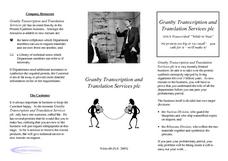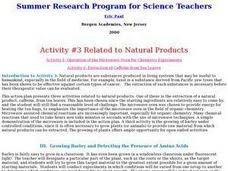Curated OER
The History of Life
In this history of life instructional activity, students use diagrams showing how life may have begun on Earth to complete 3 short answer questions.
Curated OER
DNA Transcribed
In this DNA learning exercise, students describe how the cell stores all of the data needed to produce the required proteins for the body. Then they describe the ribosomes division and how is attaches itself to RNA and makes protein by...
Curated OER
DNA
In this DNA worksheet, 9th graders read a brief excerpt pertaining to the genetic code and identify how proteins know which cell to create. Then they use the genetic code dictionary to draw a diagram showing the codons for an imaginary...
Curated OER
The Three Types of RNA
In this biology worksheet, students identify and describe the three types of RNA, messenger, transfer, and ribosomal RNA. Then they write the key features of molecules of RNA for each form.
Curated OER
BUILD A BURGER
Students recognize and name the products used to build a hamburger. They review the USDA Food Guide Pyramid. Students are given worksheets, and they match the burger parts to the picture parts. They conduct a taste test on samples of the...
Curated OER
Hunger/ Nutrition
Seventh graders investigate nutrients and nutrition to determine what types of food the body needs for energy. They study each type of nutrient and why it is important to the body. They determine what a balanced diet is by completing the...
Curated OER
Building You From Moo
Learners are given an envelope that turns each of them into either a field of grass, or a diary cow, or a famous person (only one type of organism per student). The object is to get the correct building blocks for proteins (amino acids)...
Curated OER
Building YOU from MOO
Students build protiens according to whether they are suppose to be a plant, a cow, or a person. They discover that all proteins are made from the same amino acids and it is just the order of these amino acids that change.
Curated OER
Anticodons And Amino Acids Game
Students examine the process of protein synthesis. In small groups, they select an index card, and translate the DNA to an amino acid, and define the words on an anticodon/amino acid chart.
Curated OER
Growing Barley and Detecting the Presence of Amino Acids
Pupils produce the greatest mass of plant material possible for 100 seeds of barley, and detect amino acids in barley plant material. They develop rules for the investigation, conduct the experiment, and prepare a computer spreadsheet...
Curated OER
Relationships and Biodiversity
Students examine diversity on the planet and the differences within a species. In this investigative lesson students complete a lab that allows students to better understand the relatedness between plants.
Curated OER
Chemistry Worksheet 14
In this chemistry worksheet, students sketch several diagrams of different peptide chains. Students sketch diagrams of galactose and fructose.
Curated OER
Nutrient Biochemistry
For this nutrient biochemistry worksheet, students complete the blanks with information about nucleic acids and the process. Students also draw a figure referenced in the text given.
Curated OER
Nutrient Biochemistry
In this proteins worksheet, students review how amino acids are sequenced to determine types of proteins. Students also review how proteins are used by the body. This worksheet has 2 drawing and 24 fill in the blank statements.
Curated OER
Proteins
In this biology learning exercise, students identify and locate various vocabulary terms pertaining to types of proteins. There are 22 biology terms located in the word search.
Curated OER
Biology: Protein Study
Learners in pairs, select and view proteins from the Protein Data Bank. After downloading the tutorial and instructions, they identify the protein's structures and primary biological functions. Then, students present their findings to...
National Institutes of Health
Ncbi: The Molecular Biology of the Cell: The Chemical Components of a Cell
Advanced chapter of the book "The Molecular Biology of the Cell" describes and provides illustrations of our most current understanding of the chemical makeup of cells and their components. Explains in detail how electron activity keeps...
Concord Consortium
Concord Consortium: Science of Atoms and Molecules: Nucleic Acids and Proteins
Through this activity, students work with macromolecules, proteins and nucleic acids. The focus is on the atomic structure of proteins, how linear polymers are made, and the surface charges of the resulting polymers. . Multiple-choice...
National Institutes of Health
Ncbi: Amino Acids Are Linked by Peptide Bonds to Form Polypeptide Chains
Proteins are linear polymers formed by linking the a-carboxyl group of one amino acid to the a-amino group of another amino acid with a peptide bond. The formation of a dipeptide from two amino acids is accompanied by the loss of a water...
University of Arizona
The Biology Project: Immunology: Introduction to Western Blot Activity
Simulate the Western blotting procedure used to identify specific amino-acid sequences in proteins.
Encyclopedia of Earth
Encyclopedia of Earth: Evolutionary Biology: Amino Acid
A discussion of the structure and types of amino acids, and of how they combine to form proteins. (Published: October 16, 2010)
Vision Learning
Visionlearning: Biological Molecules: Fats and Proteins
An explanation of the importance of fats and proteins in the human diet. Examples of chemical structures of various fats and proteins are used.
CK-12 Foundation
Ck 12: Central Dogma of Molecular Biology
[Free Registration/Login may be required to access all resource tools.] This module states and explains the central dogma of molecular biology which was conceived by Francis Crick.
CK-12 Foundation
Ck 12: Genetic Code
[Free Registration/Login may be required to access all resource tools.] How do you go from four letters to 20 amino acids? You need a code. This module introduces the genetic code and how to read it, defines codon and reading frame, and...























